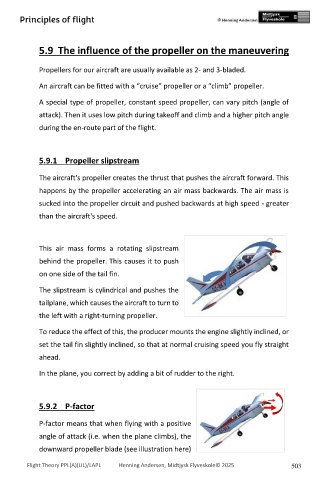Page 503 - PPL-engelsk 2025
P. 503
Principles of flight
5.9 The influence of the propeller on the maneuvering
Propellers for our aircraft are usually available as 2- and 3-bladed.
An aircraft can be fitted with a “cruise” propeller or a “climb” propeller.
A special type of propeller, constant speed propeller, can vary pitch (angle of
attack). Then it uses low pitch during takeoff and climb and a higher pitch angle
during the en-route part of the flight.
5.9.1 Propeller slipstream
The aircraft's propeller creates the thrust that pushes the aircraft forward. This
happens by the propeller accelerating an air mass backwards. The air mass is
sucked into the propeller circuit and pushed backwards at high speed - greater
than the aircraft's speed.
This air mass forms a rotating slipstream
behind the propeller. This causes it to push
on one side of the tail fin.
The slipstream is cylindrical and pushes the
tailplane, which causes the aircraft to turn to
the left with a right-turning propeller.
To reduce the effect of this, the producer mounts the engine slightly inclined, or
set the tail fin slightly inclined, so that at normal cruising speed you fly straight
ahead.
In the plane, you correct by adding a bit of rudder to the right.
5.9.2 P-factor
P-factor means that when flying with a positive
angle of attack (i.e. when the plane climbs), the
downward propeller blade (see illustration here)
Flight Theory PPL(A)(UL)/LAPL Henning Andersen, Midtjysk Flyveskole© 2025 503

